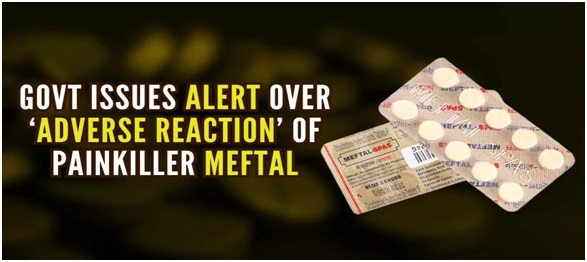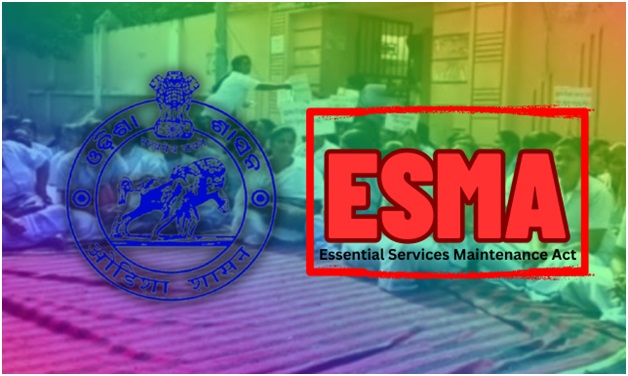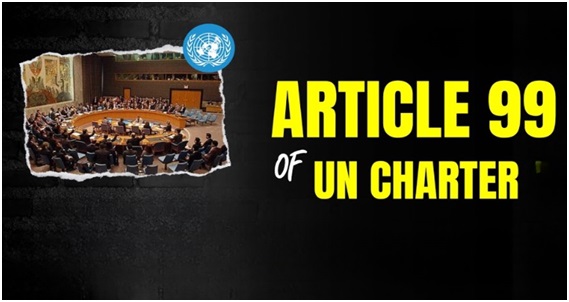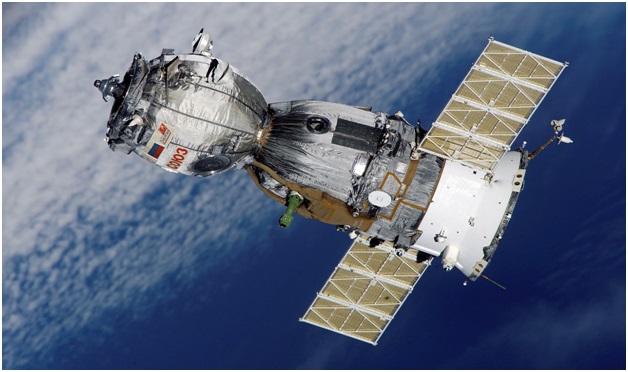Painkiller Meftal could cause DRESS syndrome (Financial Express)

- 07 Dec 2023
Why is it in the News?
Indian Pharmacopoeia Commission (IPC) has recently issued a drug safety alert for doctors and patients about the use of the commonly used painkiller mefenamic acid, popularly sold under the brand name Meftal.
Context:
- The Pharma standard body, Indian Pharmacopoeia Commission (IPC) in its preliminary analysis of Adverse Drug Reactions (ADRs) from the PvPI database revealed that Meftal can lead to Drug Reactions with Eosinophilia and Systemic Symptoms (DRESS) Syndrome.
- According to doctors, this syndrome causes a diverse array of clinical symptoms, anywhere from 2 to 8 weeks after initiating the offending drug.
What is DRESS syndrome?
- DRESS syndrome (Drug Rash with Eosinophilia and Systemic Symptoms) is an adverse reaction term that is currently used to describe a hypersensitivity reaction.
- Experts classify DRESS syndrome as a type 4 hypersensitivity reaction.
- It is a serious drug reaction affecting the skin and other organs, with a mortality rate of up to 10%.
- It manifests when the immune system excessively responds to specific medications, leading to a type 4 hypersensitivity reaction.
- This reaction can manifest with various symptoms across the body, including fever, abnormalities in blood, and inflammation of organs.
What are the symptoms of DRESS syndrome?
- Patients diagnosed with DRESS syndrome typically present with a rash, fever, and eosinophilia but can have a variety of symptoms including liver, lung, or kidney involvement.
- “DRESS syndrome should be suspected if a diffuse rash erupts and is accompanied by fever, facial edema, and enlarged lymph two to six weeks after starting a new high-risk medication.
How to treat DRESS Syndrome?
- The most important step to treat DRESS Syndrome is to stop the medication involved in the reaction, and sometimes, no further treatment is needed.
- Topical steroids can be given to treat the rash and in certain cases, further treatment is needed to protect the organs from damage, such as with steroids, which can be given either intravenously or orally.
- “Treatment with steroids can be needed for weeks or even months, and lab work is monitored carefully during this time.
- The average time to recovery is six to nine weeks.
Odisha Invokes ESMA to Ban Strikes by Health Department Staffs (The Hindu)

- 07 Dec 2023
Why is it in the News?
The Odisha Government invoked the Orissa Essential Services (Maintenance) Act (ESMA) prohibiting strikes by paramedical staff, including nurses, pharmacists, technicians, Class III and IV employees, to ensure that medical services are not disrupted.
About Essential Services Maintenance Act (ESMA):
The Indian Parliament enacted ESMA in 1968 to ensure the continuous provision of critical services crucial to people's daily lives. This legislation prohibits employees in essential services from striking, regardless of bandhs or curfews.
- Designated Essential Services: Public conservation, sanitation, water supply, hospitals, national defense, petroleum, coal, electricity, steel, fertilizer production, and banking-related services fall under the ambit of essential services.
- Communication, transportation, and government initiatives for food grain acquisition and distribution are also covered.
- State-Specific Application: State governments, individually or collaboratively, can enforce ESMA within their territories, each having its own version with slightly varied provisions.
- This allows states to address disruptions that impact specific regions.
- Central Government Activation: In the case of a nationwide disruption, especially in sectors like railways, the central government may invoke ESMA.
- Consequences for Striking Employees: Employees engaging in illegal strikes under ESMA can face disciplinary action, including dismissal. Legal consequences may involve arrests without a warrant, with imprisonment for up to one year, fines, or both for those participating or instigating the strike.
UN Secretary-General Invokes Article 99 on Humanitarian Crisis in Gaza (The Hindu)

- 07 Dec 2023
Why is it in the News?
Amid Israel’s ongoing military attacks on the Gaza Strip, particularly in its southern region, United Nations Secretary-General Antonio Guterres has invoked Article 99 of the UN Charter in a bid to establish a ceasefire.
Context:
- The United Nations Secretary-General Antonio Guterres has decided to invoke Article 99 of the UN Charter as the death toll in Israeli bombardments on Gaza crosses 16,000.
- He also urged the UN Security Council to act on the humanitarian crisis in Gaza.
- The development comes as Israel increased the intensity of its operations, especially in the areas of southern Gaza with Israel's defence leadership claiming that “half of Hamas’ battalion commanders" are killed.
What is Article 99 of the UN Charter?
- The Secretary-General may bring to the attention of the Security Council any matter which in his opinion may threaten the maintenance of international peace and security.”
- It is seen as a discretionary power.
- The responsibility it confers upon the Secretary-General will require the exercise of the highest qualities of political judgment, tact and integrity” according to a 1945 report of the Preparatory Commission of the United Nations.
- According to the UN, the President of the Security Council is under the obligation to call a meeting of the Council if the Secretary-General brings to the attention of the Council any matter under Article 99.
When has Article 99 Been Activated in the Past?
- 1960: Following the Congo Crisis, Secretary-General Dag Hammarskjöld invoked Article 99 to address the aftermath of Belgium's withdrawal and the ensuing internal conflict.
- 1971: Amid the Bangladesh Liberation War, Secretary-General U Thant activated Article 99 to draw attention to the humanitarian crisis, urging international intervention.
- 1979: In response to the Iranian Revolution and hostage crisis, Secretary-General Kurt Waldheim triggered Article 99 to underscore the seriousness of the situation and the necessity for a peaceful resolution.
- 1989: Confronted with the ongoing Lebanese Civil War and hostage abductions, Secretary-General Javier Pérez de Cuéllar invoked Article 99 to emphasize the requirement for international support and engagement.
‘Garba Of Gujarat’ Declared as Intangible Cultural Heritage by UNESCO (Indian Express)

- 07 Dec 2023
Why is it in the News?
Garba, the folk art of Gujarat, receives the intangible cultural heritage of humanity (ICH) tag from Unesco.
Context:
- 'Garba of Gujarat' has been inscribed in the Representative List of Intangible Cultural Heritage (ICH) of Humanity by UNESCO.
- The decision was taken at the 18th session of the UNESCO’s Intergovernmental Committee for Safeguarding of Intangible Cultural Heritage held in the Republic of Botswana.
- Garba of Gujarat is the 15th ICH element from India to join this list.
- This inscription underscores Garba’s pivotal role as a unifying force that fosters social and gender inclusivity.
About Garba Dance:
- Garba is a ritualistic and devotional dance deeply rooted in the traditions of Gujarat, India.
- This vibrant dance is a central part of the nine-day Navratri festival, dedicated to the worship of feminine energy or Shakti.
- The cultural richness of Garba vividly expresses the divine feminine through its performances and visuals.
- Taking place in various settings, from homes and temple courtyards to public spaces, streets, and open grounds, Garba transforms into a widespread, inclusive community celebration.
- Beyond its religious significance, Garba serves as a social equalizer, breaking down barriers related to socio-economic status, gender, and sect divisions.
- This inclusive dance form fosters community unity, bringing together diverse and marginalized groups and reinforcing social bonds.
- Notably, Garba holds the distinction of being the 15th cultural element from India to be recognized by UNESCO.
What is Intangible Cultural Heritage?
- Cultural heritage extends beyond physical structures and object collections.
- It encompasses traditions and living expressions transmitted from our forebears to descendants.
- This includes oral traditions, performing arts, social practices, rituals, festive events, and the knowledge associated with nature, the universe, as well as the skills involved in traditional craftsmanship.
Chandrayaan-3 Propulsion Module Retraces Steps to Earth Orbit (Indian Express)

- 07 Dec 2023
Why is it in the News?
Scientists have brought the Propulsion Module (PM) of the Chandrayaan-3 mission , which initially brought the Vikram lander to within 100 km of the Moon's surface before detaching and executing a historic controlled descent on August 23, back into Earth orbit.
What is a Propulsion Module in Chandrayaan-3?
- The Propulsion Module is a rectangular component of the Chandrayaan-3 spacecraft, equipped with solar panels for power.
- Its primary purpose was to transport the Lander module to the lunar polar circular orbit and facilitate its separation.
- Following separation, the SHAPE payload within the Propulsion Module was activated.
- Initially intended for a three-month operation during the mission, the ISRO announced on December 4th that the Chandrayaan-3's Propulsion Module had been manoeuvred out of lunar orbit.
- Placed high above Earth for an additional mission, the module is currently sustained by residual fuel.
- This bonus mission will showcase technologies crucial for future lunar sample retrieval, according to ISRO.
- As of now, the ISRO has not disclosed its plans for the spacecraft once it depletes its fuel.
Importance of Propulsion Module's Return to Earth's Orbit:
- ISRO highlighted the key achievements resulting from the return manoeuvres conducted on the Propulsion Module (PM) in connection to upcoming missions:
- Planning and executing the trajectory and manoeuvres for the return journey from the Moon to Earth.
- Developing a software module for planning such manoeuvres, along with its initial validation.
- Planning and executing a gravity-assisted flyby around a planet or celestial body.
- Preventing uncontrolled crashing of the PM onto the Moon's surface at the end of its life, aligning with the requirement of avoiding debris creation.
What is Chandrayaan-3 Mission?
